Assessment |
Biopsychology |
Comparative |
Cognitive |
Developmental |
Language |
Individual differences |
Personality |
Philosophy |
Social |
Methods |
Statistics |
Clinical |
Educational |
Industrial |
Professional items |
World psychology |
Professional Psychology: Debating Chamber · Psychology Journals · Psychologists
- Main article: Eye colour and behaviour
Eye color or eye colour is a polygenic trait and is determined primarily by the amount and type of pigments present in the eye's iris.[1][2] Humans and other animals have many phenotypic variations in eye color.[3] In humans, these variations in color are attributed to varying ratios of the two types of melanin produced by melanocytes in the iris: eumelanin and pheomelanin.[2] The brightly colored eyes of many bird species are largely determined by other pigments, such as pteridines, purines, and carotenoids.[4]
Three main elements within the iris contribute to its color: the melanin content of the iris pigment epithelium, the melanin content within the iris stroma, and the cellular density of the iris stroma.[5] In eyes of all colors, the iris pigment epithelium contains the black pigment, eumelanin.[2][5] Color variations among different irises are typically attributed to the melanin content within the iris stroma.[5] The density of cells within the stroma affects how much light is absorbed by the underlying pigment epithelium.[5]
Determination of eye color[]
Eye color is an inherited trait influenced by more than one gene.[6][7] In humans, three genes coding for eye color are currently known: EYCL1, EYCL2, and EYCL3.[8][9] These genes account for three phenotypic eye colors (brown, green, and blue) in humans.[3] Although it was once thought that brown eye color was always dominant and blue eye color was always recessive, the fact that two blue-eyed parents can give birth to a brown-eyed child has shown that the determination of eye color does not follow the simple rules of Mendelian inheritance.[6][10] In fact, most babies of European or Southern Asian descent tend to have blue eyes at first, then either remains that colour or turns green to brown depending on pigmentation levels. Eye colour usually stabilizes when an infant is around 6 months old. [11]
Classification of colors[]
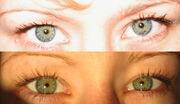
The perception of color depends upon various factors. These are the same eyes; however, depending on the light and surrounding hues, the eye color can appear quite different. There is a copper ring around the pupil.
Iris color can provide a large amount of information about an individual, and a classification of various colors may be useful in documenting pathological changes or determining how a person may respond to various ocular pharmaceuticals.[12] Various classification systems have ranged from a basic "light" or "dark" description to detailed gradings employing photographic standards for comparison.[12] Others have attempted to set objective standards of color comparison.[13]
As the perception of color is dependent upon the conditions in which color is viewed (e.g. the amount and type of illumination, as well as the hue of the surrounding environment), so is the perception of eye color.[14]
Eye color exists on a continuum from the darkest shades of brown to the lightest shades of blue.[6] Seeing the need for a standardized classification system that was simple, yet detailed enough for research purposes, Seddon et. al developed a graded one based on the predominant iris color (brown, light brown, green, gray, and blue) and the amount of brown or yellow pigment present.[15]
Brown[]
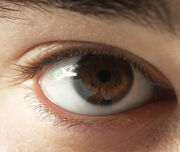
Dark brown human iris.
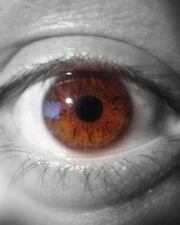
Brown human iris. The color was dropped from the image outside of the iris.
In humans, brown eyes contain large amounts of melanin (primarily eumelanin) within the iris stroma which serves to absorb light, particularly at the shorter wavelengths.[5][16] Very dark brown irises may appear to be black.[17][18]
Brown is one of the most common eye colors[19] and, in many populations, it is the only iris color present.[20]
Those with non-European ancestry generally have darker eyes and less variability in eye color than those of European descent.[21] Virtually all of the original inhabitants of Africa, Asia, and the Americas have brown eyes. Brown eyes are also found in Europe, Oceania, and North America, though within European populations they are not predominant to the same extent.[How to reference and link to summary or text] Brown had been considered to be the most dominant eye color in any gene, but new studies have revealed that this is not always true.[How to reference and link to summary or text]
Hazel[]
A hazel eye.
Hazel eyes are due to a combination of a Rayleigh scattering and a moderate amount of melanin in the iris' anterior border layer.[22][5] A number of studies using three-point scales have assigned "hazel" to be the medium-color between brown and blue.[23][24][25][26][27][28][29] This can sometimes produce a multicolored iris, i.e., an eye that is brown near the pupil and green on the outside.[citation needed]
There is some difficulty in defining the eye color "hazel" as it sometimes considered to be synonymous with brown and other times with green.[30][17][23][25][28][31] They have been described as light brown or yellowish brown,[32] or as a lighter shade of brown.[33] Hazel eyes have also been described as being equivalent to blue/gray.[34]
Amber and yellow[]
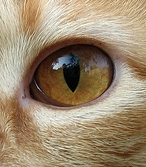
A cat's iris which is amber colored.

Human amber eyes displaying the milky greenish yellow and russet/coppery tint.
Amber colored eyes are of a solid color and have a strong yellowish/golden and russet/coppery tint. This might be due to the deposition of the yellow pigment called "lipochrome" in the iris (which is also found in green and violet eyes). [35] [36] Amber eyes are much more common in other animals than they are in humans.[citation needed] They are also nicknamed "cat eyes."[How to reference and link to summary or text]
The yellow eyes of some pigeons contain yellow fluorescing pigments known as pteridines.[37] The bright yellow eyes of the Great Horned Owl are thought to be due to the presence of the pteridine pigment xanthopterin within certain chromatophores (called xanthophores) located in the iris stroma.[38] In humans, yellow specks or patches are thought to be due to the pigment lipofuscin, also known as lipochrome.[22]
Green[]

Green eyes
Green eyes are also the product of moderate amounts of melanin.[5]
Green eye color has been linked to brown hair color. [39]
Green eyes are most often found in people of Celtic, Germanic, and Slavic descent, and to a lesser extent southern Europe.[How to reference and link to summary or text] Green eyes are also found, though in much lower proportions, among other Caucasian populations in the Middle East and South Asia.[citation needed] They are so common among Pashtuns that in Pakistan, Pashtuns are often called "Hare Ankheian Vaale": those with green eyes (Urdu translation).[How to reference and link to summary or text] They may also be found in many areas of Afghanistan (the native land of the Pashtuns) and parts of India - most common in the north, with the highest percentages respectively in Punjab, Uttar Pradesh, Gujarat, and Rajasthan.[How to reference and link to summary or text]
One of the most famous photographs ever published by National Geographic was a close-up of Sharbat Gula, a Pashtun girl with startling green eyes, taken in western Afghanistan by Steve McCurry in 1984.[citation needed] Details of her irises captured by the photograph were used to confirm her identity after she was relocated in 2002.[40]
Gray[]

Gray eyes.

Steel blue-gray eyes.
Gray eyes are a variant of blue eyes.[citation needed] Indian actress Celina Jaitley has gray eyes. A gray iris may indicate the presence of a uveitis. This is however obvious too the viewer that an eye problem exists. [41]
Blue[]
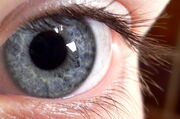
Blue eyes are relatively common throughout Europe, especially in Northern Europe, including the northern Baltics and in East Central Europe.
Blue eyes contain low amounts of melanin within the iris stroma; longer wavelengths of light tend to be absorbed by the underlying iris pigment epithelium and shorter wavelengths are reflected and undergo Rayleigh scattering.[5] The type of melanin present is primarily eumelanin.[16]
Blue eyes are found mainly in people of northern European and eastern European descent, and to a lesser extent, in people of southern Europe, the Middle East and Central Asia, most commonly in people who live at higher elevations.[How to reference and link to summary or text] South Asians may also have blue eyes, but this is uncommon, except amongst Pathans in Afghanistan, Pakistan, and India.[citation needed] It also occurs in other Indians and Pakistanis, generally in highest percentages among Punjabiis - though even then it is not exactly common.[citation needed] Finland and Lithuania have the highest proportions of blue-eyed people, with at least 80% in both countries respectively.[citation needed] Ireland and Great Britain also have high proportions of blue eyes, with estimates of around 70% for Ireland[1] and about 60% for Britain.[2]
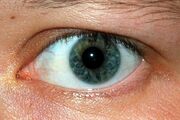
A blue-green human eye.
Blue is the color of the indole monomer that when polymerised forms melanin.[How to reference and link to summary or text] If both alleles for brown eyes (a polymerase gene) are absent or damaged, the blue color remains.[citation needed] The inheritance pattern followed by blue eyes is thought to be similar to that of a recessive trait.[7]
A 2002 study found the prevalence of blue eye color among non-Hispanic whites in the United States to be 57.4% for those born between 1899 and 1905 compared to 33.8% for those born between 1936 and 1951.[7]
One survey estimated that nearly 90% of Icelanders have blue or green eyes.[42]
As melanin production generally increases during the first few years of life, the blue eyes of some babies may darken as they get older.[43][44] Eye color typically stabilizes by 6 years of age.[45]
Violet eyes[]
The appearance of violet eyes is thought to occur due to the mixing of red and blue reflections.[46] Some albinos have eyes that appear to be violet.[47] Elizabeth Taylor's physical trademark is her "violet" eyes.[48]
Anomalous conditions[]
Aniridia[]

Aniridia: Eyes wherein the irises are not present; the eyes appear to be two large pupils.
Aniridia is a congenital condition characterized by an extremely underdeveloped iris which appears absent on superficial examination.[49]
Ocular albinism[]
In those with albinism, the color of the irises is typically blue (but can vary from blue to brown); transillumination defects can almost always be observed during an eye examination due to lack of iridial pigmentation.[50]
Because of this lack of pigment, the blood vessels underneath may lend a reddish color to the eye enhancing the red eye effect in photographs. Edgar Winter's eyes are an example of this trait.
Heterochromia[]

An example of heterochromia. The subject has one brown and one hazel eye.
- Main article: Heterochromia
Heterochromia (also known as a heterochromia iridis or heterochromia iridium) is an ocular condition in which one iris is a different color from the other iris (complete heterochromia), or where the part of one iris is a different color from the remainder (partial heterochromia or sectoral heterochromia). It is a result of the relative excess or lack of pigment within an iris or part of an iris, which may be inherited or acquired by disease or injury.[51] This uncommon condition usually results due to uneven melanin content. A number of causes are responsible, including genetics such as chimerism and Waardenburg syndrome. Trauma and certain medications, such as latanoprost can also cause increased or decreased pigmentation in one eye. On occasion the condition of having two different colored eyes is caused by blood staining the iris after sustaining injury.
Medical implications[]
Those with lighter iris color have been found to have a higher prevalence of age-related macular degeneration (ARMD) than those with darker iris color;[27] lighter eye color is also associated with an increased risk of ARMD progression.[52] An increased risk of uveal melanoma has been found in those with blue or grey iris color.[53] Darker iris colors have been found to have slightly higher intraocular pressures than lighter iris colors.[25] An increased incidence of age-related cataracts has been found in those with dark brown irises.[54][17]
References[]
- ↑ Wielgus AR, Sarna T. "Melanin in human irides of different color and age of donors." Pigment Cell Res. 2005 Dec;18(6):454-64. PMID 16280011.
- ↑ 2.0 2.1 2.2 Prota G, Hu DN, Vincensi MR, McCormick SA, Napolitano A. "Characterization of melanins in human irides and cultured uveal melanocytes from eyes of different colors." Exp Eye Res. 1998 Sep;67(3):293-9. PMID 9778410.
- ↑ 3.0 3.1 Morris, PJ. "Phenotypes and Genotypes for human eye colors." Athro Limited website. Retrieved May 10, 2006.
- ↑ Oliphant LW. "Pteridines and purines as major pigments of the avian iris." Pigment Cell Res. 1987;1(2):129-31. PMID 3507666.
- ↑ 5.0 5.1 5.2 5.3 5.4 5.5 5.6 5.7 Huiqiong Wang, Stephen Lin, Xiaopei Liu, Sing Bing Kang. "Separating Reflections in Human Iris Images for Illumination Estimation." Proc. IEEE International Conference on Computer Vision, 2005.
- ↑ 6.0 6.1 6.2 Sturm RA, Frudakis TN. "Eye colour: portals into pigmentation genes and ancestry." Trends Genet. 2004 Aug;20(8):327-32. PMID: 15262401.
- ↑ 7.0 7.1 7.2 Grant MD, Lauderdale DS. "Cohort effects in a genetically determined trait: eye colour among US whites." Ann Hum Biol. 2002 Nov-Dec;29(6):657-66. PMID 12573082.
- ↑ Rebbeck TR, Kanetsky PA, Walker AH, Holmes R, Halpern AC, Schuchter LM, Elder DE, Guerry D. "P gene as an inherited biomarker of human eye color." Cancer Epidemiol Biomarkers Prev. 2002 Aug;11(8):782-4. PMID 12163334.
- ↑ "Eye color is more complex than two genes." Athro, Limited. Retrieved September 1, 2006.
- ↑ http://www.ncbi.nlm.nih.gov/entrez/dispomim.cgi?id=227240
- ↑ http://chemistry.about.com/cs/howthingswork/f/eyecolor.htm
- ↑ 12.0 12.1 German EJ, Hurst MA, Wood D, Gilchrist J. "A novel system for the objective classification of iris colour and its correlation with response to 1% tropicamide." Ophthalmic Physiol Opt. 1998 Mar;18(2):103-10. PMID 9692029.
- ↑ Fan S, Dyer CR, Hubbard L. Quantification and Correction of Iris Color." Technical report 1495, University of Wisconsin-Madison, Dec, 2003.
- ↑ http://www.edromanguitars.com/tech/color.htm
- ↑ Seddon JM, Sahagian CR, Glynn RJ, Sperduto RD, Gragoudas ES. "Evaluation of an iris color classification system." The Eye Disorders Case-Control Study Group. Invest Ophthalmol Vis Sci. 1990 Aug;31(8):1592-8. PMID: 2201662.
- ↑ 16.0 16.1 Menon IA, Basu PK, Persad S, Avaria M, Felix CC, Kalyanaraman B. "Is there any difference in the photobiological properties of melanins isolated from human blue and brown eyes?" Br J Ophthalmol. 1987 Jul;71(7):549-52. PMID 2820463.
- ↑ 17.0 17.1 17.2 Hammond BR Jr, Fuld K, Snodderly DM. "Iris color and macular pigment optical density." Exp Eye Res. 1996 Mar;62(3):293-7. PMID 8690039. Cite error: Invalid
<ref>tag; name "Hammond" defined multiple times with different content - ↑ Prieto JG. "Eye color in skin cancer." Int J Dermatol. 1977 Jun;16(5):406-7. PMID 873674.
- ↑ Eiberg H, Mohr J. "Assignment of genes coding for brown eye colour (BEY2) and brown hair colour (HCL3) on chromosome 15q." Eur J Hum Genet. 1996;4(4):237-41. PMID 8875191.
- ↑ http://www.ncbi.nlm.nih.gov/entrez/dispomim.cgi?id=227220
- ↑ Frudakis T, Thomas M, Gaskin Z, Venkateswarlu K, Chandra KS, Ginjupalli S, Gunturi S, Natrajan S, Ponnuswamy VK, Ponnuswamy KN. Sequences associated with human iris pigmentation." Genetics. 2003 Dec;165(4):2071-83. PMID 14704187.
- ↑ 22.0 22.1 Lefohn, A., Budge, B., Shirley, P., Caruso, R., and Reinhard, E. 2003. An Ocularist's Approach to Human Iris Synthesis. IEEE Comput. Graph. Appl. 23, 6 (Nov. 2003), 70-75. DOI= http://dx.doi.org/10.1109/MCG.2003.1242384
- ↑ 23.0 23.1 Zhu G, Evans DM, Duffy DL, Montgomery GW, Medland SE, Gillespie NA, Ewen KR, Jewell M, Liew YW, Hayward NK, Sturm RA, Trent JM, Martin NG. "A genome scan for eye color in 502 twin families: most variation is due to a QTL on chromosome 15q." 1: Twin Res. 2004 Apr;7(2):197-210. PMID 15169604.
- ↑ Albert DM, Green WR, Zimbric ML, Lo C, Gangnon RE, Hope KL, Gleiser J. "Iris melanocyte numbers in Asian, African American, and Caucasian irides." Trans Am Ophthalmol Soc. 2003;101:217-21; discussion 221-2. PMID 14971580.
- ↑ 25.0 25.1 25.2 Mitchell R, Rochtchina E, Lee A, Wang JJ, Mitchell P; Blue Mountains Eye Study. "Iris color and intraocular pressure: the Blue Mountains Eye Study." Am J Ophthalmol. 2003 Mar;135(3):384-6. PMID 12614760.
- ↑ Lindsey JD, Jones HL, Hewitt EG, Angert M, Weinreb RN. "Induction of tyrosinase gene transcription in human iris organ cultures exposed to latanoprost." Arch Ophthalmol. 2001 Jun;119(6):853-60. PMID 11405836.
- ↑ 27.0 27.1 Frank RN, Puklin JE, Stock C, Canter LA. "Race, iris color, and age-related macular degeneration." Trans Am Ophthalmol Soc. 2000;98:109-15; discussion 115-7. PMID 11190014.
- ↑ 28.0 28.1 Regan S, Judge HE, Gragoudas ES, Egan KM. "Iris color as a prognostic factor in ocular melanoma." Arch Ophthalmol. 1999 Jun;117(6):811-4. PMID 10369595.
- ↑ Hawkins TA, Stewart WC, McMillan TA, Gwynn DR. "Analysis of diode, argon, and Nd: YAG peripheral iridectomy in cadaver eyes." Doc Ophthalmol. 1994;87(4):367-76. PMID 7851220.
- ↑ http://www.thetech.org/genetics/ask.php?id=126
- ↑ Naldi L, Altieri A, Imberti GL, Giordano L, Gallus S, La Vecchia C; Oncology Study Group of the Italian Group for Epidemiologic Research in Dermatology (GISED). "Cutaneous malignant melanoma in women. Phenotypic characteristics, sun exposure, and hormonal factors: a case-control study from Italy." Ann Epidemiol. 2005 Aug;15(7):545-50. PMID 16029848.
- ↑ April Holladay. "Funny — you can't hide those lightening eyes." USATODAY.com. October 8, 2004. Retrieved September 17, 2006.
- ↑ English JS, Swerdlow AJ, MacKie RM, O'Doherty CJ, Hunter JA, Clark J, Hole DJ. "Relation between phenotype and banal melanocytic naevi." Br Med J (Clin Res Ed). 1987 Jan 17;294(6565):152-4. PMID 3109545.
- ↑ Hara T. "[Increased iris pigmentation after use of latanoprost in Japanese brown eyes.]" Nippon Ganka Gakkai Zasshi. 2001 May;105(5):314-21. PMID 11406947.
- ↑ http://www.hhmi.org/cgi-bin/askascientist/highlight.pl?kw=&file=answers%2Fgenetics%2Fans_044.html
- ↑ http://www.eyecarecontacts.com/eyecolor.html
- ↑ Oliphant LW. "Observations on the pigmentation of the pigeon iris." Pigment Cell Res. 1987;1(3):202-8. PMID 3508278.
- ↑ Oliphant LW. "Crystalline pteridines in the stromal pigment cells of the iris of the great horned owl." Cell Tissue Res. 1981;217(2):387-95. PMID 7237534.
- ↑ Eiberg H, Mohr J. "Major genes of eye color and hair color linked to LU and SE." Clin Genet. 1987 Mar;31(3):186-91. PMID 3568446.
- ↑ David Braun. "How They Found National Geographic's 'Afghan Girl'" NationalGeographic.com. March 7, 2003. Retrieved November 16, 2006.
- ↑ http://www.milesresearch.com/main/eyesigns.asp
- ↑ Rafnsson V, Hrafnkelsson J, Tulinius H, Sigurgeirsson B, Olafsson JH. "Risk factors for malignant melanoma in an Icelandic population sample." Prev Med. 2004 Aug;39(2):247-52. PMID 15226032.
- ↑ http://chemistry.about.com/cs/howthingswork/f/eyecolor.htm
- ↑ http://web.archive.org/web/20060528161737/http://www.bbc.co.uk/health/ask_the_doctor/blueeyes.shtml
- ↑ Bito LZ, Matheny A, Cruickshanks KJ, Nondahl DM, Carino OB. "Eye color changes past early childhood. The Louisville Twin Study." Arch Ophthalmol. 1997 May;115(5):659-63. PMID 9152135.
- ↑ http://www.bbc.co.uk/dna/h2g2/A734933
- ↑ http://www.albinism.org/publications/what_is_albinism.html
- ↑ includeonly>Taraborrelli, J. Randy. "Violet Eyes To Die For", The Washington Post, 2006-09-03. Retrieved on 2006-11-01. (in English)
- ↑ http://www.emedicine.com/oph/topic43.htm
- ↑ http://www.emedicine.com/OPH/topic260.htm
- ↑ Imesch PD, Wallow IH, Albert DM. "The color of the human eye: a review of morphologic correlates and of some conditions that affect iridial pigmentation." Surv Ophthalmol. 1997 Feb;41 Suppl 2:S117-23. PMID 9154287.
- ↑ Nicolas CM, Robman LD, Tikellis G, Dimitrov PN, Dowrick A, Guymer RH, McCarty CA. "Iris colour, ethnic origin and progression of age-related macular degeneration." Clin Experiment Ophthalmol. 2003 Dec;31(6):465-9. PMID 14641151.
- ↑ Stang A, Ahrens W, Anastassiou G, Jockel KH. "Phenotypical characteristics, lifestyle, social class and uveal melanoma." Ophthalmic Epidemiol. 2003 Dec;10(5):293-302. PMID 14566630.
- ↑ Younan C, Mitchell P, Cumming RG, Rochtchina E, Wang JJ. "Iris color and incident cataract and cataract surgery: the Blue Mountains Eye Study." Am J Ophthalmol. 2002 Aug;134(2):273-4. PMID 12140040.
See also[]
- Iridology
- Hair color
- Human skin color
- Xanthophore
External links[]
- What Color Eyes Would Your Child Have?
- Eye color inheritance chart, discussing six different eye colors
- Genetics of eye color
- Scientific American - Ask the Experts, "How does someone get two different-colored eyes?"
- Eye colour: portals into pigmentation genes and ancestry
- Various links on human eye color
- Explanation of how someone of African descent has blue eyes
- A random Eye color generator. - Choose the genes and it produces the random eye colors.
- Eye colors in birds
da:Øjenfarve de:Augenfarbe es:Color de ojos fa:رنگ چشم gd:Dath nan sùilean pt:Olho humano fi:Silmien väri sv:Ögonfärg
